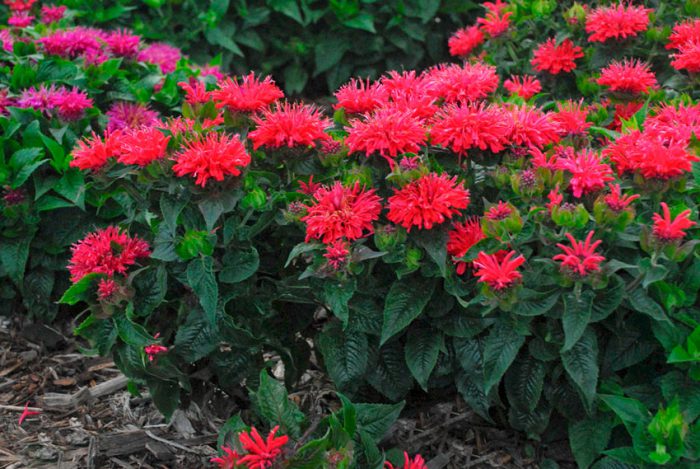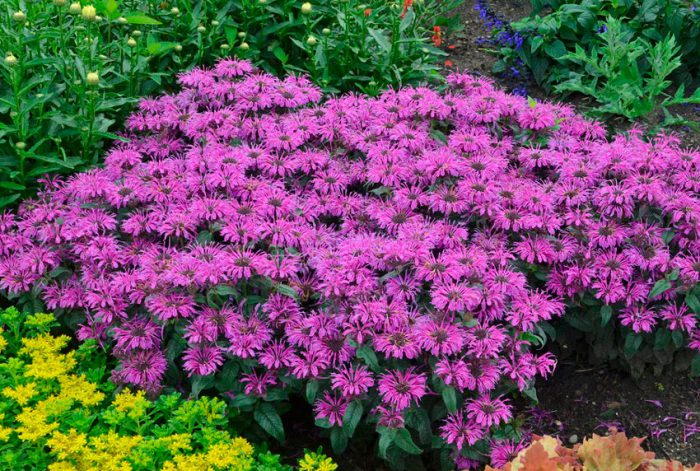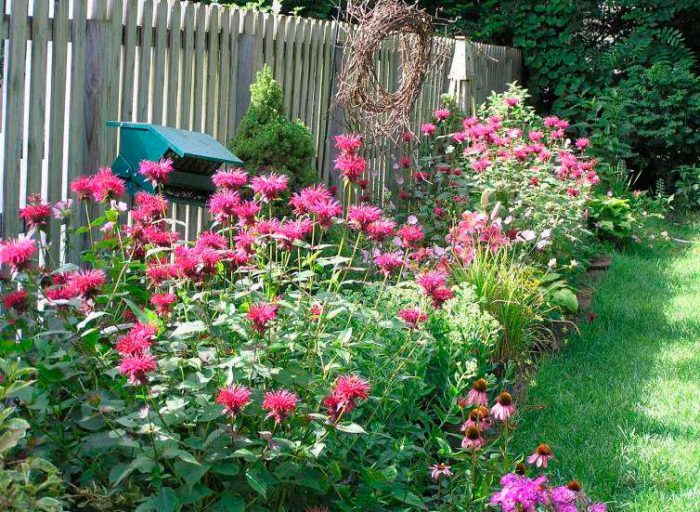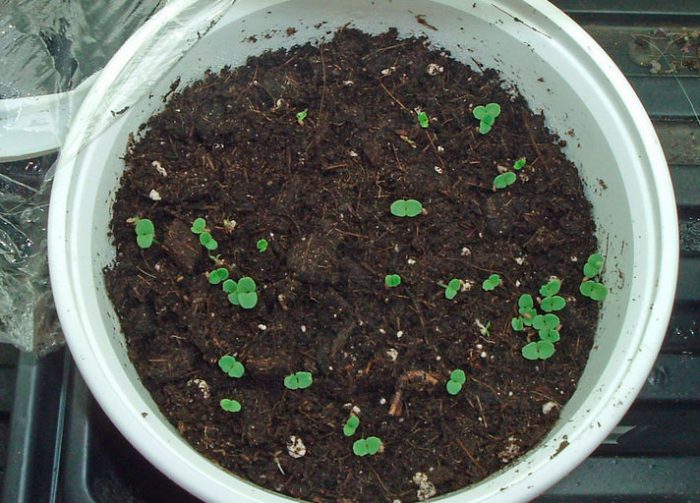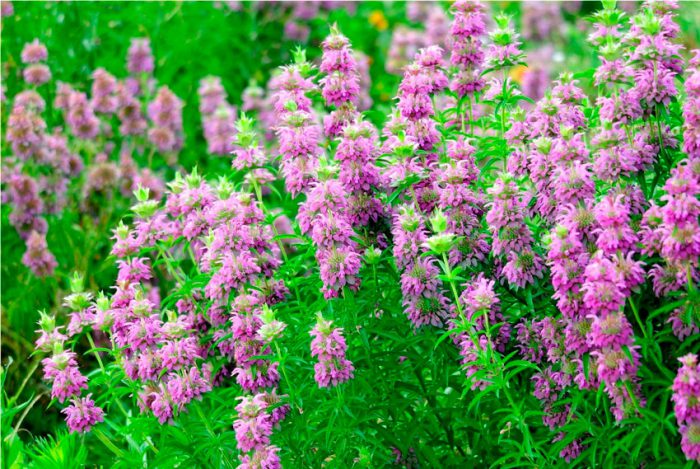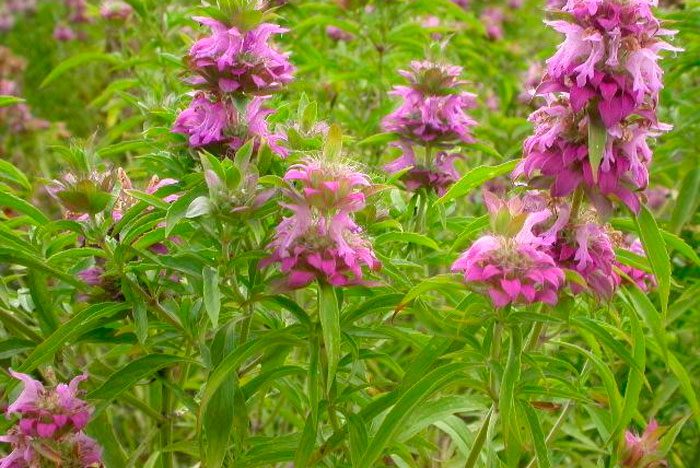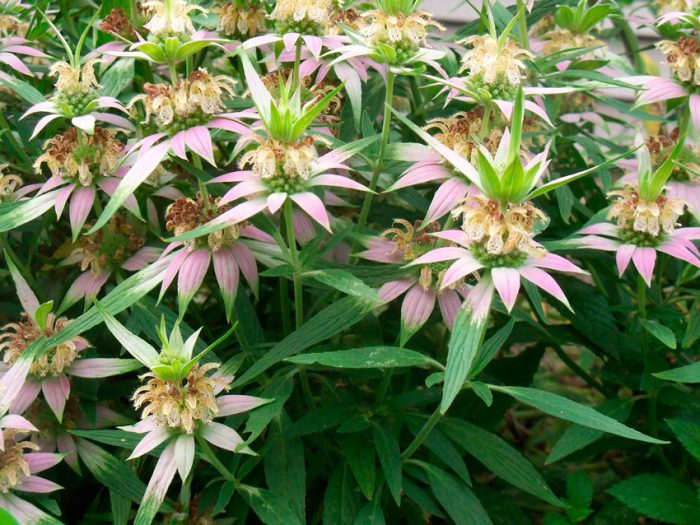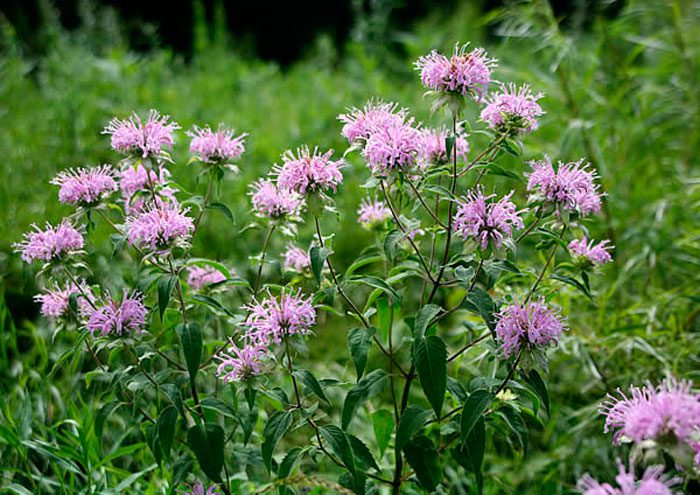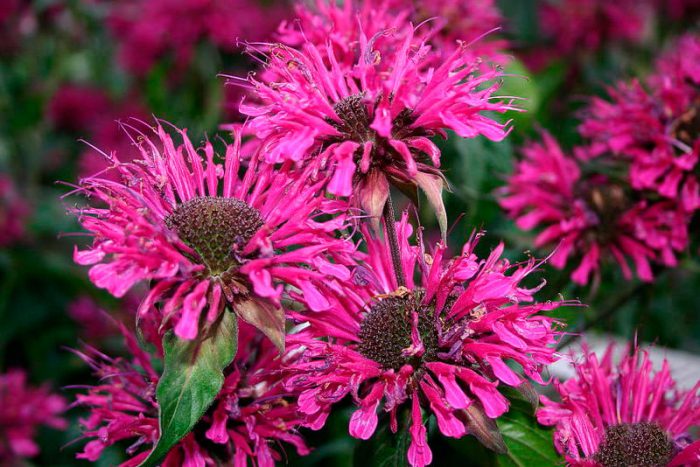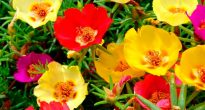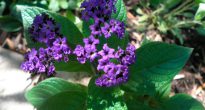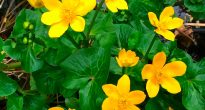Such an annual or perennial herb, like Monarda, belongs to the labiate family. This genus unites about 20 species. The homeland of such a plant is North America, where it can be found from Mexico to Canada. He gave the name to this plant by K. Linnaeus in honor of the Spaniard Nicholas Monardes, who was a botanist and doctor; in 1574 he published a book describing the plants of America. Monardes called this flower a Canadian origan or Vergin's soulmate. In European countries, monarda was cultivated as an essential oil culture, while by the 19th century it was already known around the world as bergamot, American lemon balm or lemon mint.
Content
Features of monarda
A rhizome plant such as monarda bergamot is an annual or perennial. Branched or straight shoots in height can reach up to 150 centimeters. Straight, oblong-lanceolate, serrated-edged leaf blades are generally very fragrant. Small two-lipped fragrant flowers can be purple, light yellow, white, red, and speckled. They are part of dense racemose or capitate inflorescences, which reach a diameter of 6 to 7 centimeters. They are often placed on a shoot, one above the other. The fruits are a nut, while the seeds in it remain viable for up to 3 years. In the same place, such a plant can be grown from 5 to 7 years. It has very interesting flowers that attract attention, as well as a unique pleasant aroma. Monarda is often added to tea, used as a spice, and it is also an excellent honey plant.
Growing monarda from seeds
Sowing
In the southern regions, the seeds of such a plant are sown directly into open soil on a fine February day. During a couple of cold months, the seeds will undergo natural stratification. In April, friendly shoots should already appear, they will need to be thinned out. In the event that there is snow cover on the site, then it must be removed. Then the ground should be covered with foil so that it warms up properly. After the soil is loosened, while introducing a small amount of sand into it. After that, the seeds are combined with sand (1: 4) and sown.A layer of sand should also be poured over the seeds. Seeds should be buried in the soil no more than 25 mm. Sowing in open ground is sometimes done in autumn after the seeds have been collected. In the springtime, when the seedlings appear, it remains only to plant them. A year later, the monarda will grow up, get stronger and begin to bloom. Seedlings appear extremely slowly.
Seedling
But often such a flower is grown through seedlings. In order for the seedlings of such a plant to be ready for spring planting, it must be planted in January – February, while the boxes should be filled with soil mixture for vegetable crops. It is necessary to deepen the seeds by 20–25 mm. The container is removed to the greenhouse, in which the air temperature should not drop below 20 degrees. The first seedlings can be seen after 20 days, and they begin to pick them after another 20 days, while using a 4x4 or 3x3 scheme.
Planting monarda in open ground
What time to plant
Planting a monarda and growing it in the garden is quite simple. It is best to choose a well-lit area for her, which will be protected from gusts of wind, but she can also be grown in a shaded place. The plant does not have any special requirements for the soil, however, a light calcareous soil is best suited for it. Moreover, in acidic raw soil, it develops and grows rather poorly. It is recommended to land in the spring, but the site should be prepared for this in the fall. To do this, you need to dig it up and clean it from weeds, and for each square meter, 2-3 kilograms of manure, peat or compost, 40-50 grams of superphosphate, 20-30 grams of potassium salt and 40 grams of lime are applied. In spring, before starting to plant the monarda, 20-30 grams of nitrogen fertilizer per 1 square meter should be applied to the soil.
How to plant
A couple of months after the seedlings appear, and they have 3 pairs of real leaves, the plant will need to be transplanted into open ground to a permanent place, while a distance of at least 0.6 meters should be kept between the bushes. The planted plants must be watered very well. Small frosts in spring (no more than minus 5 degrees) are not terrible for the monarda. The flowering of such a monarda, as a rule, can be seen only after 12 months, but some of the most developed specimens are able to bloom already this year.


Watch this video on YouTube
Caring for monarda in the garden
These flowers should be watered systematically, but at the same time in moderation, especially on hot days, otherwise the risk of plants becoming ill with powdery mildew increases. During very intense heat it is recommended to water them every day. If the summer period is very hot and dry, then experts advise sprinkling the soil where the monarda grows with a layer of mulch (peat or humus). It is necessary to periodically loosen the soil on the site and weed. You should also systematically feed such plants with Agricola or Kemira (granulated) at a frequency of 2 times a month from the second half of May to the first days of autumn. The monard will also be grateful if you add organic fertilizer to the soil (for example, mullein diluted with water in a ratio of 1:10). In spring and autumn, it is necessary to treat the plant with copper sulfate or Fundazol for prevention.
Reproduction of monarda
As mentioned above, such flowers can be grown from seeds, but in this case they will not be able to retain varietal characteristics. In this regard, a larger number of gardeners prefer to propagate the monarda by dividing the bush, which should be 3 or 4 years old. Division is carried out in April, after the earth warms up very well, or in the first days of autumn. The bush must be carefully removed from the ground, the root system is thoroughly washed under running water and divided into equal parts. It is necessary to process the cuts with crushed coal. Then the delenki are planted in a permanent place.As a rule, gardeners carry out transplantation with division quite often (about once every 2 or 3 years), the fact is that the delenki grow very quickly up to 100 cm in diameter.
Also, for propagation of this plant, the cuttings method is used. Cuttings from green shoots are harvested before flowering begins, and their length can vary from 8 to 10 centimeters. The sheet plates must be cut off from below, and those on top must be shortened by 1/3. Cuttings for rooting must be planted in a box filled with moistened river coarse sand. The container will need to be covered with agril and removed to a dark place. The plant should be fully rooted in 15–20 days. From the middle of the summer period, you can start transplanting cuttings into open ground to a permanent place.
Diseases and pests
This flower is highly resistant to diseases and harmful insects, but if it constantly feels a lack of water, then there is a high probability of infection with powdery mildew. To prevent this, it is necessary to water the monarda regularly, and it is also better to cover the area with a layer of mulch, which will not allow the liquid from the soil to evaporate so quickly. In some cases, the plant gets sick with rust or tobacco mosaic, and it also attracts weevils. But if this flower is strong and well-groomed, then any diseases are not afraid of it. Moreover, harmful insects do not tolerate the smell of this plant, and there is also an essential oil in the roots, which also has a deterrent effect on pests.
Monarda after flowering
Seed collection
In the last days of August or the first days of September, the seeds in the fruits fully ripen. In the event that you want to feel like a breeder, then collect the seeds and sow them immediately into open soil, or grow seedlings, which can be transplanted to a permanent place in spring. If there is a desire, then you can not sow seeds immediately, since their germination persists for 3 years. The seed method of reproduction is excellent for the species monarda, while the varietal method is recommended to be propagated exclusively in a vegetative way.
Preparation for wintering
In the event that you do not want to collect seeds, then let the fruits remain on the bush, then hungry birds can eat them in the autumn. If an annual monrada was grown on the site, then its remains must be removed, and the soil must be prepared for planting another crop. Perennials are highly frost-resistant (up to minus 25 degrees). If a winter with little snow is expected, then the site is best covered with a thick layer or covered with spruce branches.
Types and varieties of monarda with photos and names
Annual species of monarda
Monarda lemon, or citrus (Monarda citriodora)
This flower in the genus is the only annual. In height, it can reach 15–95 centimeters. On the bush are lanceolate leaf plates. The inflorescences include from 5 to 7 whorls with small dark or pale lilac flowers. In the shoots, foliage and flowers of the plant there is an essential oil, which is similar in composition to the oil of lemon balm, basil, and also mint. In this regard, this species is able not only to decorate your garden, but also help to make dishes even tastier and more aromatic.
Monarda lambada hybrid (Monarda lambada)
This species was bred in the Netherlands. To create it, breeders crossed several species of the Citriodora group. Young leaf plates have a strong lemon aroma.
Monarda punctata
This species is also called horse mint. It is grown for the highly decorative, rich salmon-colored foliage that surrounds the inflorescence. The height of the bush can be up to 0.8 m.
Perennial species of monarda
Monarda double (Monarda didyma)
In natural conditions, it can be found in the Great Lakes region. The height of such a herbaceous perennial plant can reach 0.8 m. The expanding rhizome is horizontal, tetrahedral leafy shoots are erect.Opposite oval leaf plates have pubescence, a short petiole, a serrated edge and a pointed apical tip. They are green in color and about 12 centimeters long, as well as red stipules. Small lilac or purple flowers are part of the dense end capitate inflorescences, reaching about 6 centimeters in diameter. Large leafy bracts are painted in almost the same color as the flowers. It has been cultivated since 1656.
Monarda fistulosa, or tubular (Monarda fistulosa)
Under natural conditions, it can be found in forests in the eastern territories of North America. In European countries, this species is cultivated, as a rule, as a spicy aromatic plant. Such a perennial has many shoots, reaching a height of 0.65-1.2 meters. Simple sheet plates with a serrated edge have a pubescence of fine hairs. Small lilac flowers are collected in false whorls that surround light red stipules; they are part of the capitate spherical inflorescences. On each of the peduncles there are 5-9 inflorescences, reaching from 5 to 7 centimeters in diameter. It has been cultivated since 1637. There is a dwarf form of this type of Victoria, which is a merit of Russian breeders.
Monarda hybrid (Monarda x hybrida)
This species includes varieties and forms that were bred by American, German and English breeders, while in their work they used the fistus monarda and the double monarda. The bush can reach a height of 1 meter, while the flowers have a very different color, for example:
- purple-violet: Blue Stocking, Blaustrumpf;
- purple: Zinta-Zinta, Fishee and Pony;
- magenta: Prairie Glow, Sunset and Cardinal;
- red: Cambridge Scarlett, Adam, Mahogeny, Petite Delight, Balance and Squaw;
- pink: Croftway Pink, Cratley Pink and Rose Queen;
- white: Snow White, Snow Maiden and Schneevitchen;
- burgundy: Bordeaux Moldova and Prairienakht;
- lavender: Elsiz Levende.
There is also the Panorama variety population, which includes monards with flowers of various colors: white, pink, crimson, purple, burgundy and scarlet.
Monarda properties
Medicinal properties
All parts of the monarda contain vitamins B1, B2 and C, essential oils and other biologically active elements. Therefore, it is widely used in alternative medicine. The essential oil obtained from this plant is very valuable. It has properties such as: antibacterial, sedative, antioxidant, reproductive and antianemic. If you regularly drink oil, you can remove atherosclerotic plaques from the aorta, cure colds, flu, and radiation sickness, as well as improve the immune system and support the body after chemotherapy. Also monarda is used for cystitis, pneumonia, otitis media, sinusitis and disorders of the digestive processes. It is also used for headaches, diseases of the oral cavity, nail and foot fungus. Such a flower is also used in cosmetology, it is added to creams for mature skin, as well as to care products for problematic and oily skin.
The foliage of the plant can be added to salads, tea and soups, and it is also used as a side dish for fish or vegetable dishes.
Contraindications
Experts do not recommend using Monarda to treat children under five years of age, as well as pregnant women and during breastfeeding. However, it cannot be used both for oral administration and for aroma lamps.
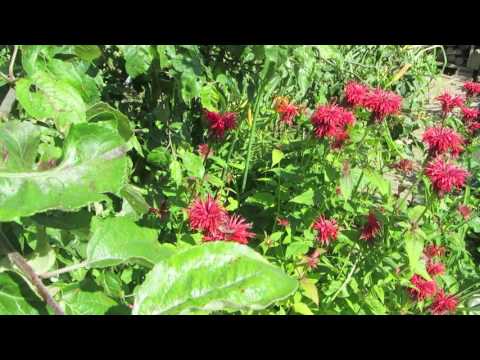

Watch this video on YouTube

